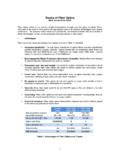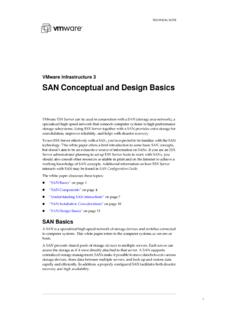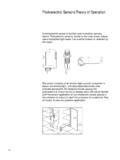Transcription of OM4 - The Next Generation of Multimode Fiber - …
1 OPTICAL Fiber IN ENTERPRISE APPLICATIONS. OM4 - The next Generation of Multimode Fiber Tony Irujo Sales Engineer As the demand for bandwidth in this paper describes the tech- also known as differential mode enterprise applications such as nology behind OM4 Fiber , high- delay (DMD), and maximizes data centers continues to lights the key differences with bandwidth, which is the amount boom, new transmission media other Fiber types, and explains of information that can travel must be developed continually how its high bandwidth is through the Fiber per unit of to meet end user requirements. ensured through stringent time. The latest in optical transmis- measurement methods. sion media for the enterprise is In addition to their large core, called OM4 Fiber . Multimode Fiber Basics Multimode fibers have a large Compared to single-mode Numerical Aperture (NA), the OM4 Fiber is a 50 micron ( m) fibers, Multimode fibers have maximum angle at which a Fiber laser-optimized Multimode Fiber larger cores that, as their name can accept the light that will be with extended bandwidth.
2 It is implies, guide multiple modes transmitted through it. This designed to enhance the sys- or rays of light simultaneously. allows them to work with rela- tem cost benefits enabled by Modes that travel at the outside tively low-cost optical compo- 850 nm Vertical Cavity Surface edge of the core have a longer nents and light sources such as Emitting Lasers (VCSELs) for distance to go than modes that light-emitting diodes (LEDs). existing 1 and 10 Gb/s applica- travel near the center. and VCSELs. tions as well as future 40 and 100 Gb/s systems. The core's graded index profile Multimode Fiber Options is designed to slow down Multimode products are identi- Supporting Ethernet, Fibre modes that have a shorter dis- fied by the OM ( optical multi- Channel, and OIF applications, tance to travel so that all modes mode ) designation as outlined OM4 Fiber allows extended arrive at the end of the Fiber as in the ISO/IEC 11801 interna- reach upwards of 550 meters at close in time as possible.
3 This tional cabling standard (see 10 Gb/s for ultra long building minimizes modal dispersion, table 1). backbones and medium length campus backbones. It offers an Effective Modal Bandwidth (EMB) of 4700 MHz-km, more than double the IEEE require- ment for 10 Gb/s 300 meter support. To help you use this advanced Fiber to its greatest advantage, Table 1: ISO/IEC 11801 OM designations OM4 Fiber is the latest develop- It has been proposed that stan- erned by the amount of chemi- ment in this series. It is espe- dards organizations perform a cal dopant Germanium at that cially well suited for shorter thorough review of BIMMFs, location in the core. Because reach data center and high per- and incorporate them into modes traveling down the cen- formance computing applica- industry standards. Until this ter of the core have shorter dis- tions, where optical loss budg- work is done, some caution is tance to travel than those trav- ets are tight at 10 Gb/s (and advised before widespread eling along the edge, the refrac- are expected to get even tighter adoption takes place.)
4 Tive index profile in a Multimode at 40 Gb/s and 100 Gb/s). The Fiber must be graded in a par- high bandwidth provided by What Makes OM4 Different? abolic manner across the core. OM4 Fiber when deployed at Like OM3 Multimode Fiber , OM4 This slows down the modes less than its rated distance Fiber is considered to be laser- that have a shorter distance to offers extra headroom for optimized, or optimized for use travel, equalizing the arrival channel insertion loss. with VCSEL light sources. OM3 time of all the modes. and OM4 fibers are designed OM4 is backward compatible and manufactured in such a The better the modes are with applications calling for OFL way as to get the most perform- equalized, the higher the band- bandwidth of at least 500 MHz- ance out of VCSELs compared width of the Fiber . Mode equal- km at 1300 nm ( , FDDI, to LEDs.
5 That is why laser-opti- ization depends on how well IEEE 100 BASE-FX, mized fibers are specified using the graded index profile is con- 1000 BASE-LX, 10 GBASE-LX4, Laser Bandwidth, or EMB. structed during Fiber manufac- and 10 GBASE-LRM). turing. The more precise the OM2 Fiber , although compatible refractive index profile is in The latest offerings in multi- with VCSELs, is not considered terms of shape, curvature and mode Fiber are 50 m bend to be laser-optimized. OM2 smoothness (free of dips, insensitive Multimode fibers Fiber is intended for use with spikes or defects), the better (BIMMF). These fibers have LED sources at speeds of 10 or the modes will be equalized been promoted as offering all 100 Mb/s, or for shorter reach 1 (see Figure 2). the advantages of high band- Gb/s networks. You can use width laser-optimized multi- OM2 Fiber with VCSELs, but its OM4 Fiber , with its higher band- mode Fiber , with the added performance is limited to 550 width, has an extremely precise advantage of lower bend sensi- meters at 1 Gb/s and only 82 refractive index profile, virtually tivity.
6 Meters at 10 Gb/s, compared to free of perturbations or defects. OM4 Fiber 's However, recent work has reach of over pointed to some areas of con- 1000 meters cern with these fibers. Studies at 1 Gb/s and have identified issues with the 550 meters at characterization of bend insen- 10 Gb/s. sitive fibers, and questioned whether current requirements As discussed, are adequate to guarantee sys- the speed at tem performance. Additional which each studies have shown that mating mode travels (connector) loss of BIMMFs down a multi- with standard fibers is higher mode Fiber 's than with standard fibers con- core depends nected to each other. This addi- on its refrac- tional loss adds to the total link tive index, Figure 2: A refractive index profile optimized for shape, curvature loss. which is gov- and smoothness maximizes bandwidth. In order to make such a precise Fiber , one needs to use a pre- form manufacturing process that has exceptional control over the amount of Germanium that is incorporated at particular sub-micron positions within the Fiber 's core.
7 An example of a process that lends itself to this level of control is OFS' propri- etary MCVD process, in which each layer of the core is Figure 3: DMD testing measures how different VCSELs fill different modes in each deposited and sintered individu- Fiber . ally, providing the utmost in refractive index precision and VCSELs that launch more differing amounts of power in uniformity. power into outer modes. That is each path. Overfilled bandwidth why the existing OM3 Fiber measurements, used to meas- OM4 Fiber Standards standards require a minimum ure LED bandwidth, could not Two standards define the use 1500 MHz-km OFL bandwidth emulate the operation of a of OM4 Fiber in high-speed net- at 850 nm. VCSEL. works: TIA document TIA- 492 AAAD, which contains the For OM4 Fiber , OFS and others The standards allow two ways OM4 Fiber performance specifi- in the standards group strongly to measure and verify laser cations; and the IEC 60793-2- recommended at least 3500 bandwidth: the DMD Mask 10 international standard, which MHz-km OFL bandwidth in Method, and the EMBc Method.
8 Provides equivalent OM4 speci- order to ensure the utmost per- Both methods require DMD. fications under Fiber type formance and reliability; ulti- testing -- the difference lies in ISO/IEC 11801 will add OM4 mately, that is the specification how the DMD data is used and Fiber as an industry-recognized that was agreed upon. interpreted. Fiber type, and IEEE for 40G and 100G Ethernet will Measuring Laser Bandwidth In DMD testing, small, high- include OM4 Fiber as an option Bandwidth performance of OM4 powered laser pulses are trans- that provides a reach of 150 Fiber is ensured using the same mitted through the Fiber in tiny meters (50 percent greater than criteria as OM3, but to much steps across the entire core of OM3). tighter specifications. Due to a the Fiber . Only a few modes are challenge posed when the now- excited at each step, and their There was discussion and familiar VCSEL was first intro- arrival times are recorded.
9 The debate within the standards duced, new measurement DMD of the Fiber is the differ- groups about a minimum OFL methods had to be developed ence between the earliest and bandwidth requirement at 850 to verify laser bandwidth of the latest arrival times of all nm. Although current applica- OM3 and OM4 fibers. modes at all steps. tions primarily use 850 nm VCSEL lasers with fibers that Unlike an LED, laser VCSELs DMD measurement is currently are specified to a minimum produce an energy output that the only reliable method for ver- EMB, there was good reason to is not uniform; it can change ifying bandwidth required for 10. also establish a minimum 850 sharply across the face of the Gb/s performance, because it is nm OFL bandwidth specifica- output. What's more, each laser the only method that checks all tion. It has been shown that fills a different set of light paths modes across the Fiber core fibers with higher OFL band- in each Fiber , and does so with independently.
10 For that reason, width will perform better with industry associations such as rect and more complex sent a sampling of the launch TIA/EIA and ISO/IEC have pub- process. It takes the DMD characteristics of the many lished standards for DMD results and matches them VCSELs that could actually be measurement and DMD specifi- against a set of theoretical used in a real system, the cations for laser-optimized mul- "weighting functions" that are EMBc method does not provide timode Fiber . intended to represent the the same scrutiny on Fiber qual- launch distributions of all com- ity and performance as the The DMD Mask Method is a pliant VCSELs. DMD Mask technique. What's simple process that directly more, the EMBc method virtual- compares DMD test results The DMD results are combined ly ignores the center 0 5 m against a set of specifications mathematically with each of the (radial) region of a Fiber 's core (called templates or masks) to 10 weighting functions.






